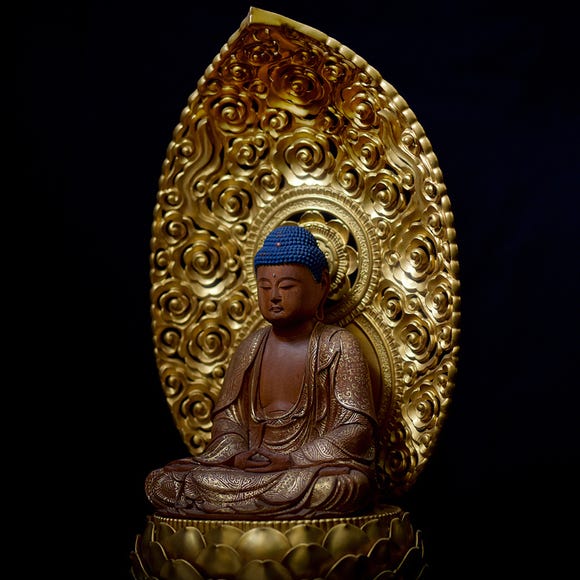
Throughout Japanese culture, sculptures have always played an important role to convey not only the zeitgeist of their era, but also to express people’s ideas and images about religion and philosophy. From animal motifs borrowed from early shamanistic beliefs, and more defined statues of deities in Buddhist temples and Shintō shrines, to politically motivated sculptures in the 20th century that incorporated a Western aesthetic, as well as modern works that convey a strong message with bold shapes and bright colors – understanding the sculptures and artworks created by Japanese artists throughout history gives a unique and deep glimpse into Japanese culture, be it traditional or modern.
From the Asuka to the Heian Period
The Asuka period (538 - 710) marks the time of the official introduction of Buddhism to Japan, as written in the Nihon Shoki, one of Japan’s oldest and most important historical documents. As such, it comes to no surprise that the focus of sculpturing drastically shifted to depictions of these newly introduced deities as temples were built and sects were founded. The majority of these sculptures were made by carving wood.
By the Heian period (794 - 1185), Buddhism had spread to every part of Japan and sculptures were made with distinctive regional features. Furthermore, Buddhist deities were no longer the only ones who were given a shape, and in particular, Shintō deities were began to be created. Apart from camphor trees, some of the preferred materials for sculpturing included Japanese cypress and nutmeg trees.
The Edo Period
The most representative work of sculpturing art from the Edo Period is the famous Tōshō-gū Shrine in Nikkō. It was built on the orders of the Japan’s third Shogun Tokugawa Iemitsu and it is decorated with over 5,000 different sculptures. About 508 of them can be found on the magnificent gate called Yōmeimon, where dragons, sages, and various animals from different folk tales and myths tell their stories – the detailed coloring techniques of the era are represented beautifully as well.
The Meiji Period and Modernity
With the country’s opening to the West with the beginning of the Meiji period, Japanese artists began incorporating a variety of new techniques, materials, and styles. Today, all kind of things are made into sculptures - not just metal, plastic, or stainless steel but also unique materials such as bananas or pencil lead. Japanese sculpturing evolves with almost every passing day, while never forsaking traditional aesthetics and methods entirely.
The number of not only Japanese tourists, but also international visitors to Kanagawa Prefecture’s Hakone Open-Air Museum continues to increase every year. In a unique outdoor exhibition, the museum showcases a large number of different sculptures and installations so interesting, that one day is hardly enough to fully experience the exhibition. Many of them were designed with an interactive purpose in mind, encouraging both children and kids at heart to climb them and play to their heart’s desire.
Art Festivals in Japan
In recent years, art festivals have been held in increased numbers all over Japan, some of them specifically showcasing local artists and works. Apart from urban areas, many a festival is sprawled over vast green fields and surrounded by lush nature, or sometimes directly beside the sea. These unique locations offer a whole new perspective on the harmony between modern society and the environment.
Modern technology hasn’t only brought forth various new materials to be used but also the development of new processing methods. This, of course, is also reflected in the art of sculpturing and various multi-dimensional works and performances that do not limit themselves to classic standards or boundaries can be enjoyed in various locations.
*Prices and options mentioned are subject to change.
*Unless stated otherwise, all prices include tax.
Popular Tours & Activitiess
Recommended places for you
-

Kanzenkoshitsuyakinikutabehodai Gyugyu Paradise Sannomiya
Yakiniku
Kobe, Sannomiya, Kitano
-
Appealing

Rukku and Uohei
Izakaya
Sapporo / Chitose
-

Jukuseiniku-to Namamottsuarera Nikubaru Italian Nikutaria Sannomiya
Izakaya
Kobe, Sannomiya, Kitano
-

ISHIDAYA Hanare
Yakiniku
Kobe, Sannomiya, Kitano
-

Kambei Sannomiyahonten
Yakiniku
Kobe, Sannomiya, Kitano
-
Goods

Yoshida Gennojo-Roho Kyoto Buddhist Altars
Gift Shops
Nijo Castle, Kyoto Imperial Palace
-

Half-Day Getaway from Tokyo: Cherry Blossoms, Local Culture and Samurai Vibes at Odawara Castle
-

Autumn in Japan 2025: Fall Foliage Forecast & Where to Enjoy the Colorful Leaves (+Tour Info)
-

Where to Buy Electronics in Ikebukuro: 6 Tax-Free Shops for Tourists in Tokyo
by: Ran Tanaka
-
Ad

A Tokyo Souvenir with Soul: The Handcrafted Leather of Bunkoya Oozeki
-

Shizuoka Road Trip: Explore the Home of Mt. Fuji with a 3-Day Rental Car Itinerary
-
Ad

Ohta’s Isan Gets a Refresh: Introducing the New Ohta’s Isan S and Ohta’s Isan <Sachet> S with Updated Packaging and Improved Benefits
-

Sumikawa Snow Park: Skiing in Northern Japan's Breathtaking Backcountry
-

10 Must-Visit Places for Autumn Leaves in Tohoku: Naruko Gorge, Geibikei Gorge & More (2025)
by: Guest Contributor
-

Day Trip from Sapporo to Otaru: Access, Itinerary & Food Guide
by: Guest Contributor
-

Dining in Kyoto: Best Restaurants for Kaiseki, Sushi, Cafes & More
-

Why Osaka Tennoji Zoo is So Popular with Foreign Tourists (Guide & Highlights)
-

Hakodate 2-Day Itinerary for Exploring Japan's Foodie North!
- #best sushi japan
- #what to do in odaiba
- #what to bring to japan
- #new years in tokyo
- #best ramen japan
- #what to buy in ameyoko
- #japanese nail trends
- #things to do japan
- #onsen tattoo friendly tokyo
- #daiso
- #best coffee japan
- #best japanese soft drinks
- #best yakiniku japan
- #japanese fashion culture
- #japanese convenience store snacks












